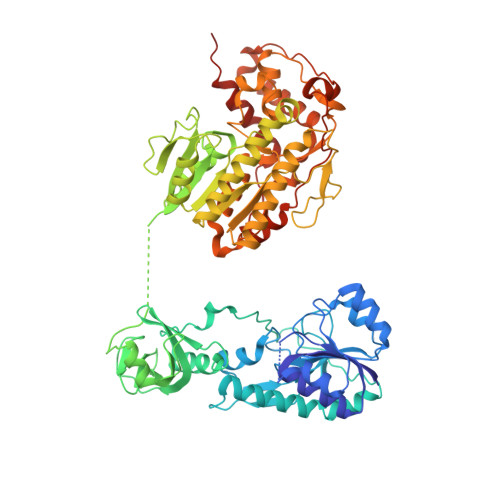Targeting the Conformational Change in ArnA Dehydrogenase for Selective Inhibition of Polymyxin Resistance.
Mitchell, M.E., Gatzeva-Topalova, P.Z., Bargmann, A.D., Sammakia, T., Sousa, M.C.(2023) Biochemistry 62: 2216-2227
- PubMed: 37410993
- DOI: https://doi.org/10.1021/acs.biochem.3c00227
- Primary Citation of Related Structures:
8FTN, 8GJH - PubMed Abstract:
Polymyxins are important last resort antibiotics for the treatment of infections caused by multidrug-resistant Gram-negative pathogens. However, pathogens have acquired resistance to polymyxins through a pathway that modifies lipid A with 4-amino-4-deoxy-l-arabinose (Ara4N). Inhibition of this pathway is, therefore, a desirable strategy to combat polymyxin resistance. The first pathway-specific reaction is an NAD + -dependent oxidative decarboxylation of UDP-glucuronic acid (UDP-GlcA) catalyzed by the dehydrogenase domain of ArnA (ArnA_DH). We present the crystal structure of Salmonella enterica serovar typhimurium ArnA in complex with UDP-GlcA showing that binding of the sugar nucleotide is sufficient to trigger a conformational change conserved in bacterial ArnA_DHs but absent in its human homologs, as confirmed by structure and sequence analysis. Ligand binding assays show that the conformational change is essential for NAD + binding and catalysis. Enzyme activity and binding assays show that (i) UDP-GlcA analogs lacking the 6' carboxylic acid bind the enzyme but fail to trigger the conformational change, resulting in poor inhibition, and (ii) the uridine monophosphate moiety of the substrate provides most of the ligand binding energy. Mutation of asparagine 492 to alanine (N492A) disrupts the ability of ArnA_DH to undergo the conformational change while retaining substrate binding, suggesting that N492 is involved in sensing the 6' carboxylate in the substrate. These results identify the UDP-GlcA-induced conformational change in ArnA_DH as an essential mechanistic step in bacterial enzymes, providing a platform for selective inhibition.
Organizational Affiliation:
Department of Biochemistry, University of Colorado Boulder, Boulder, Colorado 80309, United States.















